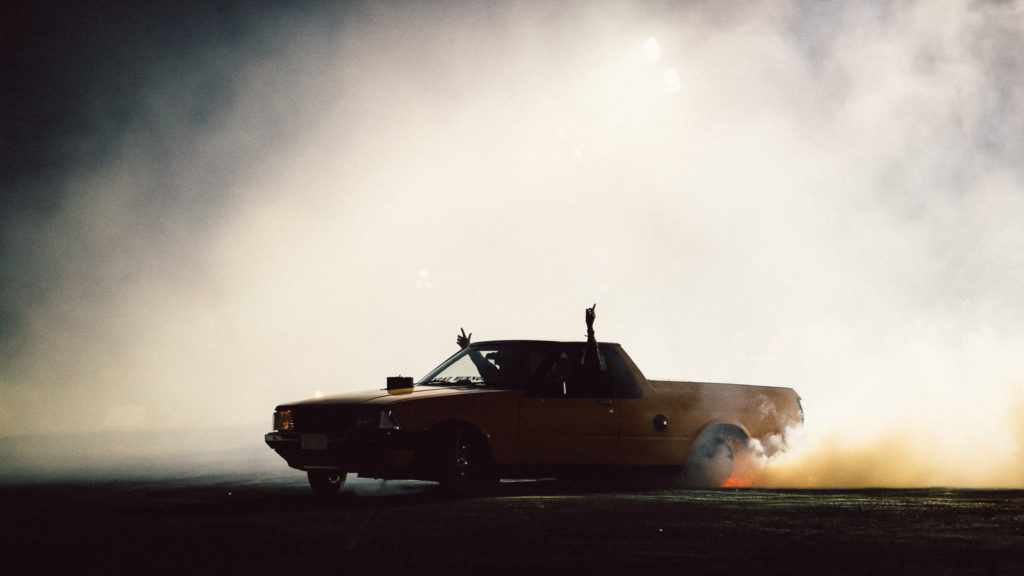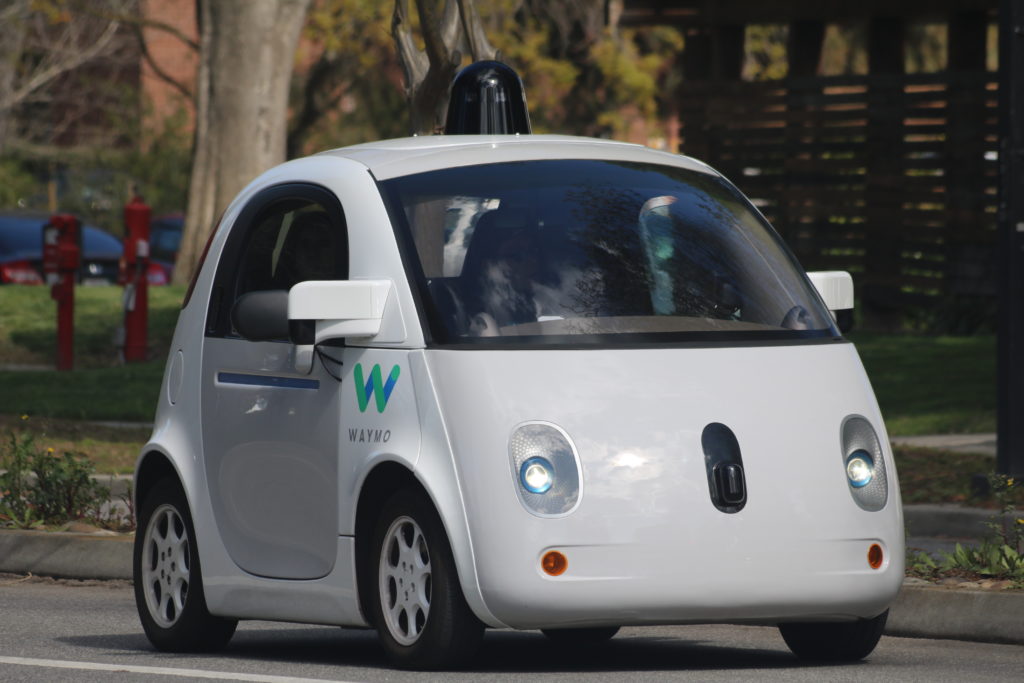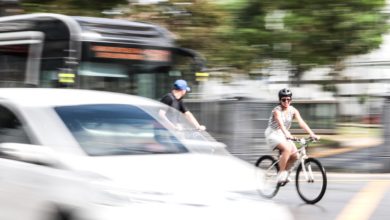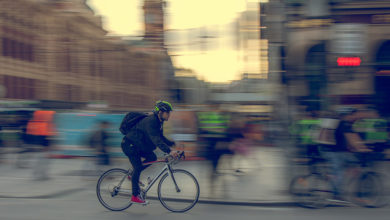
Learning to live with aggressionless cars
Does a future of driverless cars spell the end of human-centred design? Simon Sellars reflects on a new book that looks at how humans will act in a future with cars in control.
In the new book Learning to Live Together: Humans, Cars and Kerbs in Solidarity, the authors, Guillermo Fernández-Abascal and Urtzi Grau, focus on autonomous cars. They’re interested in the ways that driverless technologies shape the urban environment by idealising it within public discourse.
They discuss how Google, Volkswagen and Uber are not only invested in developing the technology, but also in pushing a sanitised version of the city:
These visions move beyond our immediate future and tend to focus on a distant time in which driverless cars populate the road and human behaviour remains unchanged, in which a society has somehow learned to live harmoniously with autonomous vehicles.
– Guillermo Fernández-Abascal and Urtzi Grau, Learning to Live Together: Humans, Cars and Kerbs in Solidarity
Yet, as Learning to Live Together highlights, there are inevitable conflicts arising from the integration of driverless technology into urban life. Such struggles are “fast, disruptive and do not preclude a unitary urban solution. Rather, they force us to re-imagine the cohabitation of humans and cars.”

Fernández-Abascal and Grau move onto a stimulating dissection of the ways we might learn to live with these new developments, including a call for the construction of a “collective project around a socio-technical challenge… a more dynamic and participatory process where contributors reflect and act together.”
I believe that this type of reflection is critical. However, I’m not sure the transition will be peaceful or even immediately solvable. After being welded to the intimate contours of the machine for so long, I think our bodies might rebel before our cities do.
In an essay included in the book, Liam Young suggests that driverless cars represent the end of human-centred design. For Young, they spell the death of “a system of architectural conventions based around our own bodies that until now has seemed satisfactory.”
Agency is an essential topic in any discussion of driverless vehicles. For so long, the car has signified a sort of primitive posthumanism, illustrated in a range of cultural artefacts that include J.G. Ballard’s novel Crash (1973), Peter Weir’s cult film The Cars that Ate Paris (1974), Paul Bartel’s Death Race 2000 (1975) and George Miller’s first Mad Max film (1979).
In registers that include surrealism (Ballard), satire (Bartel) and horror (Weir and Miller), these works critique how, through the simple act of driving, we have become cyborgs by stealth, outsourcing mobility to the machine, which is controlled by the reactions of our brain and nervous system.
In Crash, when the narrator drops acid and goes for a drive across London’s airlocked motorway system, he imagines the contours of his own body becoming indistinguishable from the machinic parameters of his vehicle:
The bones of my forearms formed a solid coupling with the shift of the steering column… The murmur of the transmission system reverberated through my legs and spine, echoing off the plates of my skull as if I myself were lying in the transmission tunnel of the car, my hands taking the torque of the crankshaft, my legs spinning to propel the vehicle forwards.
With driverless cars, however, physical functions don’t so much merge with the machine as become completely replaced by it. The question no longer concerns a primitive posthumanism but a new singularity, for here is the moment in which the machine completely surpasses the human and absorbs it until there is nothing left. What new aggressions will be released then? What new conflicts?
When autonomous vehicles take over the market, will our rewired physiologies go gently into the night? Or will we witness the flowering of strange new mutations and bizarre new psychopathologies—the product of a traumatic untethering from long-held machine fantasies?
In Speed and Politics, Paul Virilio discusses historical attempts to control, through political means, the latent aggression inherent in the automobile. These observations are worth reviewing as autonomous vehicles creep into mass awareness:
The great automobile has been emasculated, its road holding is defective and its powerful motor is bridled. Just as for the laws on speed limits, we are talking acts of government, in other words of the political control of the highway, aiming precisely at limiting the extraordinary power of assault that motorisation of the masses creates… Can asphalt be a political territory? Is the bourgeoise state and its power the street, or in the street?
We might well see a battle for asphalt once driverless technology comes into play. Virilio discusses the political control of speed as a way to curb anti-social—and therefore anti-government—impulses, but we must recognise that autonomous vehicles also seek to limit anti-social behaviour: through their focus on safety and the solving of ethical dilemmas when faced with crash situations. In each case, rebellion is almost guaranteed.
Many people living in Australia are familiar with hoon culture and the nightly performance of burn outs, fishtails and drags. Such rituals seem to perform certain functions. They’re a peacock display, a show of strength, a middle finger to suburban squares.
Whatever the case, hoon culture is embedded in the Australian psyche as the Mad Max films brutally demonstrate. It is allowed to flourish through the technology of the car. The trappings of car culture can be said to perform a certain societal function: the funnelling of aggressive impulses that might return to haunt us elsewhere if that coded system was not in place. Can the act of driving therefore be considered a safety valve? What will become of hoons when driverless cars become the only vehicle on the roads?
In America, farmers have started to purchase hacked blackmarket firmware in order to bypass the computerised John Deere tractors that dominate the farming industry. They do this because they want to take back control of their sovereignty. Normally, the tractors are locked down by chip so that unauthorised repairs can’t be done on them, but with the blackmarket code, farmers are back inside the machine and back in control.
Will we see the hacking of autonomous cars by neo-hoons of the near-future in order to continue their nightly rituals and reclaim their sovereign rights? Maybe they will hack the cars of other hapless drivers and hoon around by remote control, sending unsuspecting innocents on death rides through suburban streets. It sounds comical, but there’s a scene in The Cars that Ate Paris that is prophetic in this regard.
The film is set in the fictional Australian town of Paris, where the local economy is entirely predicated upon the instrument of the car crash. The locals deliberately manufacture road accidents to ensnare passing motorists, then they scavenge the crash sites, cannibalising car parts to make hybrid vehicles or jewellery and fetish objects. Any survivors are lobotomised by the town doctor and forced to perform the community’s menial work.
Meanwhile, Parisian hoons rev up their muscle cars in all-night drags. This behaviour is tolerated by the locals, with the hoons perceived as a byproduct of the town’s peculiar economy. One cannot exist without the other, a paradox that functions as a soft negation of the sort of scenario described by Virilio. By allowing anti-social impulses a little breathing space, full-scale anarchy is averted. In the film’s Paris, the street indeed becomes a political territory, since identical impulses—in the guise of civic duty—are used to keep the town operational.
One night, the hoons destroy the mayor’s property during a particularly lively drag race. This action proves to be the spark that lights the fuse, because it’s one thing to tolerate objectionable behaviour in the name of law and order but quite another to idly stand by when the head of state is threatened.
Subsequently, the mayor orders the cars of the gang leaders to be burned in the main street in what is effectively a public execution—of the machine. The scales in the pact with aggression are tipped in favour of the emasculation and bridling of the ‘powerful motor’.
The Cars that Ate Paris ends in civil war as the hoons take revenge, coming back bigger and badder with lethal, spike-encrusted vehicles. These monstrous machines murder civilians and destroy the town hall and other symbols of Parisian society in an orgy of tyre smoke and gear-crashing destruction.
What’s remarkable about this development is that the new machinic armour of the vehicles renders them devoid of any human agency. The metallic spikes that now festoon the vehicles seem to have been grown. Windows are covered up, obscuring the interiors, and the former human drivers are never seen again. The suggestion is that these machines have somehow come alive to exact their hideous revenge, and the soundtrack reinforces the point with animal noises as they take centre stage.
In essence, these beasts have become autonomous vehicles, and in the context of our discussion, we might see them as the return of the repressed. Framed against a backdrop of ruins and devastated streets, they are a possible glimpse at the dark underbelly in our looming future of driverless cars.
Having ‘grown’ our machinic bodies in a certain way—recall Ballard’s “bones of my forearms [forming] a solid coupling with the shift of the steering column”—the trauma of enforced separation from our prostheses might function as a form of phantom limb syndrome.
Sometimes, when a person loses a limb, the brain continues to receive messages from nerves once attached to the missing part. Repressed memories of actions that used to be performed by the limb are surfaced through previously mapped neural connections. Sometimes, this results in severe pain as the brain amplifies the sensation in order to compensate for the phantom limb. Treatment can involve a range of techniques including nerve stimulation, narcotics and even the use of mirrors to simulate the missing limb—a rewiring of the physical and psychological self.
In Learning to Live Together, the authors argue that:
The arrival of self-driving cars will change the way we design streets and roads. Throughout the history of the streetscape and its transformation, each meaningful innovation in vehicular technology has led to subtle but important adjustments in the layout of vehicular infrastructure.
However, the task must also be to plan and design for the moment when the machine is wrested away from our control and the safety valve of metered aggression no longer exists.
If we are to remap our cities in preparation for this looming future, then we must also rewire our brains.
Simon Sellars is a writer and editor. His theory-fiction novel, Applied Ballardianism: Memoir from a Parallel Universe, was described by The Guardian as “a brilliantly written genre mashup, a wonderfully original mix of cultural theory, literary exegesis, travelogue and psychopathological memoir.” Simon is the former editor of Architectural Review Asia Pacific and a former research associate at RMIT University’s Spatial Information Architecture Laboratory. His new novel, currently a work in progress, features sentient autonomous cars as central characters.
Learning to Live Together: Humans, Cars and Kerbs in Solidarity is available for purchase through Bookshop by Uro.


